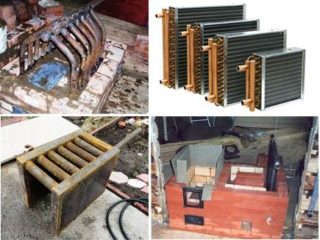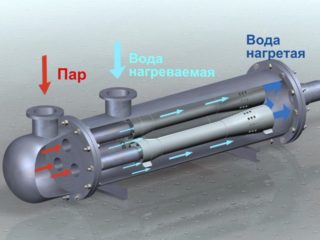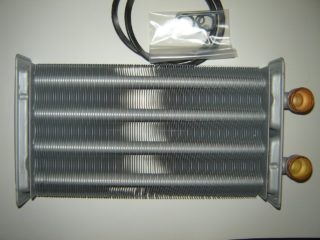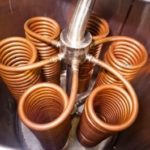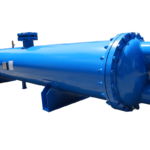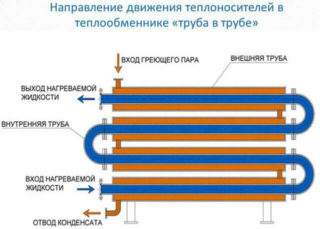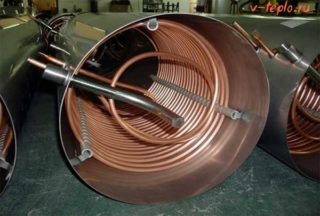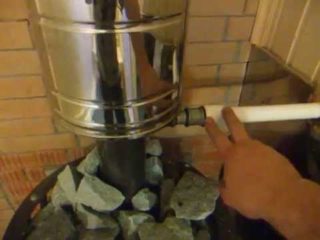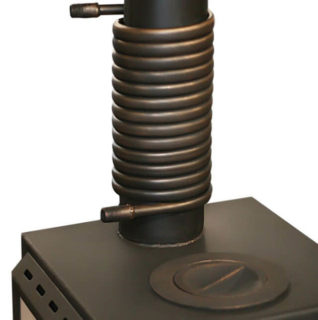A heat exchanger (TO) is a device that transfers heat between media with different temperatures. Such equipment is used in industry, heating, air conditioning and ventilation systems. The simplest example is a room radiator, it is heated by a heat-transfer fluid and provides heating for the room in which it is located.
Heat exchanger structure
The equipment consists of fixed and movable plates; each has openings for the movement of the medium. Between the main plates, many other smaller secondary ones are installed, so that every second of them is turned to the neighboring ones by 180 degrees. Minor plates are sealed with rubber gaskets.
The second important element of maintenance is the coolant. It flows through the corrugated stainless steel channels. Cold and hot media move along all plates, except the first and last, simultaneously, but from different sides, preventing mixing. At a high flow rate of water in the corrugated layer, turbulence occurs, which increases the heat transfer process.
The device is connected to the pipeline using the holes on the front and rear walls. The coolant enters on the one hand, passes through all the channels and leaves the equipment on the other. The inlet and outlet openings are sealed with a special gasket.
The channels forming plates are a very important element of maintenance. When choosing a heat exchanger, its performance must be taken into account. The higher the requirements for equipment, the more plates should be in it. Their number is responsible for the overall efficiency of the device and the ability to heat a certain room.
Types of maintenance
According to the principle of operation, the equipment is divided into regenerative and regenerative. In the first, the moving heat carriers are separated by a wall. This is the most common type, it can be of various shapes and designs. In the second case, hot and cold coolants are in turn contacted with the same surface in turn. High temperature heats the wall of the equipment during contact with a hot medium, then the temperature is transferred to the cold liquid in contact with it.
According to their intended purpose, TO are divided into two types: cooling - they work with a cold liquid or gas, while cooling the hot coolant; and heating - interact with a heated medium, giving energy to cold flows.
By design, heat exchangers come in several forms.
Collapsible
They consist of a frame, two end chambers, separate plates separated by heat-resistant gaskets and fixing bolts. Such equipment is characterized by ease of cleaning and the possibility of increasing efficiency by adding plates. But collapsible TOs are sensitive to water quality. To extend their service life, the installation of additional filters is required, which increases the cost of the project.
Lamellar
Differ in the method of connecting the inner plates:
- In brazed TOs, 0.5 mm thick stainless steel corrugated plates are cold formed. A gasket made of special heat-resistant rubber is installed between them.
- The welded plates are welded and form cassettes, which are then assembled inside the steel plates.
- In semi-welded TO cartridges are fastened by means of paronite joints in a structure of a small number of welded modules. These modules are sealed with rubber gaskets and laser welded.Then they are assembled between two plates using bolts.
Plate heat exchangers are used in high pressure and extreme temperatures. Such devices require minimal maintenance, are economical and highly efficient. In addition, if necessary, you can increase or decrease the efficiency of the equipment by increasing or decreasing the number of steel plates.
The only drawback of a corrugated stainless steel heat exchanger is its sensitivity to the quality of the coolant; additional filters are required.
Shell and tube
They consist of a cylindrical body where bundles of tubes assembled in lattices are placed. The ends of the pipes are fastened by flaring, welding or soldering. The advantage of such equipment is the undemanding quality of the coolant and the possibility of use in technical processes where aggressive media and high pressure are present (in the oil, gas, and chemical industries). The disadvantages of shell-and-tube maintenance are relatively low heat transfer, large dimensions, high cost and difficulty in repair.
Spiral
Consist of two sheets of metal, rolled in a spiral. The inner edges are connected by a partition and secured with pins. Such heat exchangers are compact and have the effect of self-cleaning. They are able to work with liquid heterogeneous media of any quality. With increasing fluid velocity, the heat transfer rate increases. Disadvantages: difficulty in manufacturing and repair, limiting the pressure of the working fluid to 10 kgf / cm².
- Spiral
- Shell and tube
Double pipe and pipe in pipe
The first consists of pipes of different diameters. As a coolant, liquid and gas are used. The devices are used in places with high pressure, have a high level of heat transfer. Differ in simplicity of installation and service. The only drawback is the high cost.
The pipe-in-pipe heat exchanger consists of two pipes of different diameters, interconnected. They are used at low flow rates and to equip the chimney.
The type of its operation depends on the type of device. From the design of equipment - the effectiveness when operating in certain conditions. Therefore, sufficient attention should be paid to the study of the characteristics of each type of equipment.
DIY heat exchanger manufacturing
To do it yourself, you need to have certain knowledge and skills. To begin with, it is worth determining what requirements the equipment should fulfill, the device variant depends on this. It is necessary to calculate materials and carry out a drawing of the future maintenance.
A bathhouse is a place where it is often necessary to make a home-made heat exchanger. Since a conventional furnace with a furnace heats a limited volume of liquid, a water immersion twisted MOT may be required. It is designed to heat more water. A coil is lowered into a tank with a heated coolant, water passes through it.
When it is necessary to keep the water in the tank hot, the tank is connected to the heating boiler using two supply and return pipes.
Water-water
To make a water-water heat exchanger with your own hands you will need:
- A stainless steel tank is 50-60 cm high and 30-40 cm in diameter. Ordinary steel can also be used, but it must be protected by a durable polymer coating.
- Cap for the tank.
- Copper pipe about 10m. The length is taken from the calculation: for each coil of a spiral with a diameter of 30 cm, about 1 m of the tube goes. It is better to take with a small margin.
- Welding machine for stainless steel and copper brazing.
- Protective equipment: gloves, mask for welding.
The work is performed in the following order:
- A lid for the tank is made and its durable tight seal is provided. It is impossible to weld it, because it must be removed to be able to clean the inside of the container. The most convenient mounting option in this case is flanged. It can be ordered immediately with the tank, or made independently. The number of holes is calculated based on the location of the seal, usually 4 or 6 mounts.
- Next, an entrance for cold water is created at the bottom of the tank and an outlet for heated in its upper part in the side wall. Threaded adapters are welded into the holes to connect the pipeline. It should be possible to remove the structure for washing or repair.
- The next step will be the manufacture of a copper spiral. If the tube is soft, it is easily wound with a mandrel. If it is stiff, you must use a burner. Fittings are welded onto the free ends. They are held through the holes on the lid. It is important to monitor the tightness of the solder, as hot water piping will be connected to the adapters.
- The final step will be the assembly of the heat exchanger. To do this, a lid with a spiral of copper pipe and a rubber seal covers the tank. Flange mounts are tightened with bolts. In this case, it is necessary to ensure that the spiral is strictly in the middle of the tank, without touching the walls. Otherwise, the effectiveness of maintenance will greatly decrease.
The considered option is also suitable for heating water in private homes. Such devices operate on the principle of natural circulation: a wood or gas boiler heats the water, it rises up the supply pipe, gives off heat and descends back. The process is then repeated.
It is not always possible to provide a constant natural circulation. Therefore, it is better to use a circulation pump.
Air
The device consists of a housing and tubes with a heated medium installed in it. Through them, the fan drives a stream of air to which heat is transferred. A heat exchange process occurs. This option is called a heater.
Also, for ventilation and air heating systems, plate structures are used. There, the role of the heat transfer wall is played by corrugated metal. Where two streams of air, cold and warm, move perpendicular to each other. They are separated by plates so that in the gaps the warm and cold flows are arranged alternately. The efficiency of these devices is high, but they are difficult for independent manufacture.
Installation procedure for air maintenance:
- A body is made of a sheet of metal. The area of its lower part should be equal to the size of the fan. For a centrifugal structure, a box with an area of 70% more than the outlet pipe is taken.
- In the walls of the box on opposite sides, holes are drilled for the copper tube.
- In the holes made, prepared pipe sections are installed so that their edges extend beyond the box by 2 cm on both sides.
- Angled fittings are welded to the free ends of the tubes. They are connected in the form of a snake. You can make two parallel. So the coolant will cool less when blowing.
- Threaded adapters are soldered to the output and input ends, and a water supply is connected to them. Water is supplied, check that the connections are tight.
- The housing is mounted on a base with a fan. The design is closed by a casing so that the air flow does not go to the sides.
To make a heat exchanger for heating a private house with your own hands, it is necessary to present the principle of its operation, to make an accurate calculation of the required power for sufficient heating of the room, especially in winter. You need to use the most thermally conductive materials, copper will be the best option. It has an efficiency far exceeding other metals.All actions in the manufacture of TO should be done carefully, avoiding the ingress of foreign objects. If there is self-doubt, it is better to contact an experienced master. He will perform the connection of all elements in a high-quality and tight manner.
